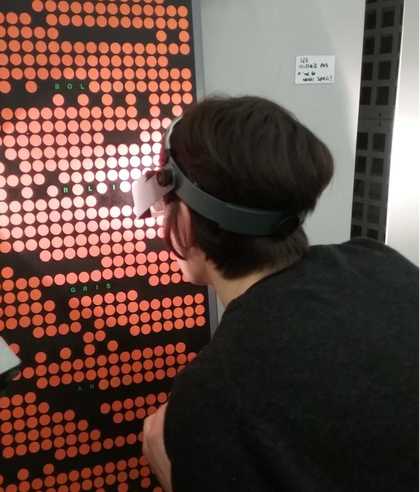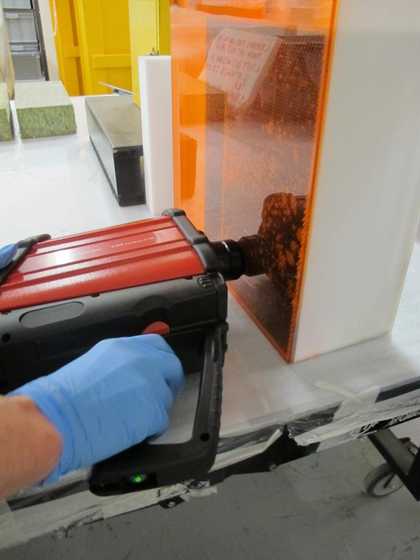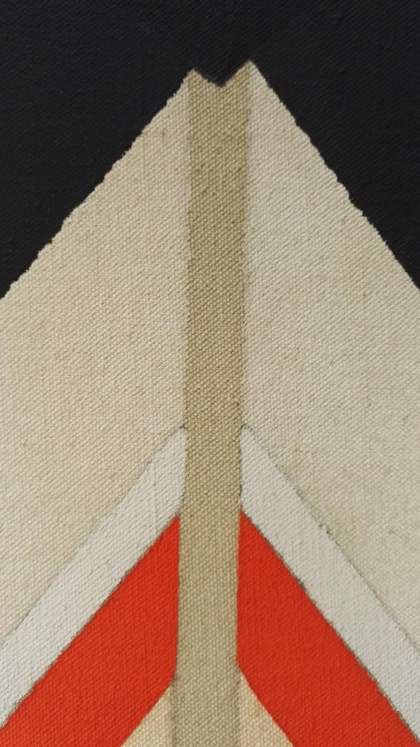In our last update we introduced a new conservation research project, in which Tate is a partner, that began in mid-2015 and will run through November 2018 – NANORESTART. In collaboration with institutions throughout Europe and beyond, we will evaluate novel systems for cleaning the sensitive surfaces of modern and contemporary artworks made of plastic or painted with synthetic polymer paints. When undertaking such a study, we always work on test samples and ‘mock-ups’ , prepared by using materials that approximate the works of art as best we can. However, eventually, we need to evaluate the efficacy of any cleaning strategy on an artwork that would benefit from treatment, in order to understand how the new methods perform in the real world. For this reason, the Tate NANORESTART team has been corresponding and meeting with our curators and conservators, seeking suggestions for potential case study candidates. We whittled down the initial list (Tate has more than 80,000 works of art) to approximately 15 artworks, aiming for a final selection of 3 case studies. Our next task was to choose the final three from the shortlist.

Conservation Science/NANORESTART Researcher Dr. Lora Angelova examining a painting from the case study shortlist – Keith Milow’s River (T011866).
Photo © Tate
One of our top choices, Bridget Riley’s Fall (T00616), had to be removed from the shortlist when we discovered that the painting is currently in the travelling exhibition An Imagined Museum and then due to be displayed again shortly after. For a careful and well-rounded study, we need to have access to the artwork for approximately 6 months.
As the remaining artworks on the list were available for the duration of the research project, we moved forward with the next step: examination and analysis. Four of the candidates were plastic sculptures which are currently not on display. Because such objects often have smooth, glossy surfaces and are typically composed of a single piece of plastic, they are rarely sampled for scientific analysis. Instead, on the visit to the storage facility, we used our portable infra-red spectrometer – an instrument which allows us to determine the general material composition of an object without the need to obtain even a microscopic sample. With the portable spectrometer, an infra-red light beam is directed at the surface of the object, which causes the molecules composing the material to absorb some of the light energy and vibrate. The result is that the original light beam will now have some ‘gaps’. We can analyse these gaps to determine the composition of the plastic; this way we can differentiate PVC (poly(vinyl chloride)) from PET (poly(ethyleneterephthalate)) plastic for example – these two polymers would vibrate differently, and leave different sets of gaps in the infra-red light beam.

Tate’s Principal Conservation Scientist Dr. Bronwyn Ormsby using a portable infra-red spectrometer to investigate the plastic composition of Op Structure, a plastic artwork by Michael Dillon (T03717) chosen as a case study for the NANORESTART project
Image Tate 2015 © Michael Dillon
Determining the material composition of the artwork is critical for ensuring that the best treatment and preservation strategy is undertaken for its future stability. In this case, we also needed to determine if the shortlisted artworks are composed of plastics appropriate for our research project. One object we examined, Keith Milow’s 1, 2, 3, 4, 5, 6… B (T01213), turned out to be composed primarily of a resin that is not included in the scope of the NANORESTART project. Not only did this disqualify the piece from the shortlist, but the resin, initially transparent, had become slightly yellowed throughout due to ageing, which means that it would not directly benefit from a surface cleaning treatment.
When we carried out analysis on the shortlisted paintings, we encountered a case of misinterpretation – a large painting noted as ‘acrylic on canvas’ turned out to be primarily executed in oil paints. Although the painting was made in 1984, and would fit within the project’s aim of addressing cleaning issues of contemporary art, we felt that an oil painting may be better suited to the concurrent and closely related Cleaning Modern Oil Paints (CMOP) project. Two other paintings we examined were composed of poly(vinyl acetate) – PVA –paints, but in both cases, the artists had used very little of the polymer binder and a lot of pigment to create a matte or velvety look to the pictorial surfaces. The conservator on our team, Annette King, ascertained that cleaning such artworks would be best carried out by very gentle brushing with a soft brush, and as can be the case with modern and contemporary art, hence, a wet surface cleaning treatment would not be necessary or appropriate.

A detail from Ernest Trova’s Falling Man 80 (T00666) showing the extremely lean paint, matte surface, and numerous areas of unpainted canvas which would require a careful dry cleaning strategy
Image Tate 2016 © Ernest Trova
Another of the shortlisted artworks was on display in the galleries at Tate Britain. To examine this potential case study candidate, we had to go into the galleries before the museum opened to the public and carefully study the piece whilst it was still hanging on the wall. During the examination we decided that the surface cleaning of this lacquered object would benefit from established conservation methods and was not suitable for trials with the new Nanorestart systems.
Little-by-little, our shortlist became even shorter. Eventually, we were able to select 3 artworks which fit all of our criteria: available during the NANORESTART project timeframe; composed of synthetic plastic or synthetic polymer paint, or both; appropriate for a wet-surface cleaning treatment; and having a complex surface which cannot be easily treated with traditional methods. Over the next 18 months, we will be preparing test sample ‘mock-ups’ which mimic each of these artworks as best we can – work that often involves working in collaboration with the artist – and artificially ageing them in the equivalent of museum conditions. We will then begin our initial cleaning tests following a systematic, methodical approach. Working in collaboration with a different Tate conservator for each case study, we will undertake the careful, informed surface conservation treatment of the artworks themselves.
Stay tuned for details about the first case study…
Lora Angelova, Bronwyn Ormsby
August 2016
